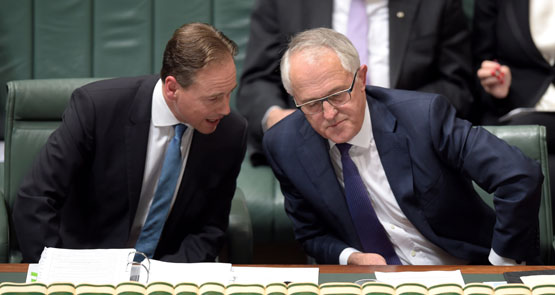We are the hollow men
We are the stuffed men
Leaning together
Headpiece filled with straw.
The many Liberal Party figures who observed Greg Hunt’s abandonment of his commitment to serious action on climate change in order to keep his job after the ascension of Tony Abbott in 2009 — some with amusement, some with mockery, many with both — can only have been impressed with the now-Environment Minister’s on-a-dime about-face on climate action following the restoration of Turnbull.
Hunt, who alternately co-operated with or was rolled continually by the right under Abbott, is suddenly an enthusiast for renewable energy, which was the subject of a hatred of almost religious intensity on the part of Abbott and then-Treasurer Joe Hockey. In just a couple of weeks under his recycled leader, Hunt has hinted at government support for storage technology, talked up bigger roles of the Clean Energy Finance Corporation and the Australian Renewable Energy Agency despite retaining the “formal position” that both be abolished and even said Tony Abbott’s ambition to further slash the RET had been abandoned.
Lots of words from Hunt, but the government’s “formal position” is still pathetically weak emissions targets to be achieved, we’re told, by the “direct action” policy that Turnbull cruelly and forensically tore apart in 2010 — and with no additional funding for that policy. That is, the Coalition’s current position is that funding for “direct action”, which was aimed at achieving a 5% reduction in 2000-level emissions by 2020 (no one outside the government seriously believed that, but let’s ignore that for now), doesn’t have to increase a cent in order to achieve an emissions reduction of at least 26% on 2005 emissions by 2030.
In fact, the cost of doing that via “direct action” is estimated to be between $100 and $250 billion — an estimate not from the Greens or environmental groups, but from the hardheads at Australian Industry Group. There’s also the laughable “safeguards” mechanism, which by Hunt’s own admission is explicitly designed to make sure no polluter ever has to pay a fine for pumping out emissions above their previous levels after getting taxpayer money not to do so.
Labor plans an emissions trading scheme and a dramatic ramp-up in investment in renewable energy. The fact that it was prepared to commit to a carbon pricing mechanism even while Abbott was prime minister demonstrated an unexpected assurance on the issue for the party that Abbott had relentlessly pursued over Julia Gillard’s carbon pricing scheme. But there is no detail of any kind so far from Labor about its policies, so we have no clue as to how they would work or their budgetary and industry implications.
Labor is still further ahead on the issue than the Coalition, however, because Turnbull knows perfectly well that he has a significant problem: “direct action” won’t even achieve the 5% goal, let alone higher ones. Indeed, thanks to the abolition of Labor’s emissions trading scheme, Turnbull has inherited an economy in which emissions intensity is actually surging in electricity generation. Moreover his joint partyroom continues to contain large numbers of climate denialists, such as Australia’s next Deputy Prime Minister Barnaby Joyce, who appears to genuinely believe a cool day is evidence that climate change is a myth, as well mining industry representatives like Josh Frydenberg, who is eager to inherit Tony Abbott’s mantle as Australia’s most dogged coal spruiker.
Turnbull either has to pump a lot more money into “direct action” — bearing in mind that each subsequent round of abatement purchases pushes the price up and reduces the abatement obtained per taxpayer dollar spent — or allow the Australian economy to remain one of the world’s most emissions intensive and let big polluters buy emissions reductions from overseas via the dodgy international carbon trading markets that Abbott used to rail against. Although, of course, that might look an awful lot like an emissions trading scheme of the kind the denialists won’t let Turnbull implement. The only alternative is massive government investment in renewable energy to dramatically accelerate the demise of coal-fired power, or a tightening of regulations around renewables — to in effect reverse Abbott and Hunt’s slashing of the RET and then some.
Heavy-handed government intervention or massive government spending — all from “a thoroughly Liberal government committed to freedom, the individual and the market”. Still, no matter what option Turnbull goes for, he can at least be assured his Environment Minister will enthusiastically spruik it.









Surely Turnbull is bound by that deal – and as for that swivel-headed dummy “Stark” Hunt, his patter depends on whose lap he’s sat, with their hand up his “operating” parts?
“an environmental fig leaf to cover a determination to do nothing”.was Turnbulls description of the direct action policy along with “fiscal recklessness on a grand scale”…I wonder how much agility the great explainer is going to require to extricate himself from a policy that he crossed the floor to vote against..?
Hmm I don’t think it’s as dire as that. Lenore Taylor has written about the potential of the ‘safeguard mechanism’ to be significantly dialled up by introducing more stringent emissions caps, which are reduced over the years. Not as tidy as an ETS but might help get the job done. http://www.theguardian.com/environment/2015/sep/15/with-a-nip-and-a-bit-of-tuck-turnbull-can-bring-a-touch-of-green-to-direct-action
The best that can be said of ghunt is that he is the epitome of a meretricious mediocrity, willing to do, say or be anything for advancement.
If the Abbotrocious government was a Conferderacy of Dunces then that of Silver Ming II could best be described as a Rule by Meretrix – available to the highest bidder.
I thought that Turnbull has said that the Clean Energy Finance Corporation will still not finance wind power, he’s not entirely our saviour Bernard.